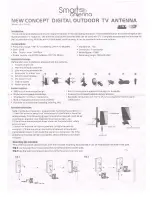
GPS-702L
The GPS-702L is an active antenna
designed to operate at the GPS L1 and L2
frequencies, 1575.42 and 1227.60 MHz
and across the L-Band from 1525 to 1560
MHz. It also has excellent reception of low
elevation angle satellites (for example,
CDGPS, OmniSTAR, GPS, SBAS). The 702L can be distin-
guished from other GPS-700 models by its grey rim. This guide
provides the basic information you need to install and begin
using your new antenna.
ADDITIONAL EQUIPMENT REQUIRED
The equipment listed below is required to set up the GPS-702L:
•
A mount, such as a range pole, tribrach, or tripod, with a
5/8" x 11 thread that extends between 3/8" and 7/8" (9
mm and 22 mm)
•
A 1" open-end wrench
•
Coaxial cable with a male TNC connector
•
A device with an antenna input port that both receives
the RF signal and provides 4.5 - 18.0 VDC to the
antenna (All NovAtel GPS receivers provide the neces-
sary power through their antenna RF connectors.)
SITE SELECTION GUIDELINES
Before installing the antenna, select a site that as closely as
possible meets the following conditions for optimal performance:
•
An unobstructed line-of-sight from horizon to horizon
and at all bearings and elevation angles
•
As far as possible from RF reflective objects, especially
those that are above the antenna and any water bodies,
which can be a strong source of multipath reflections
•
If obstructions and RF reflective surfaces are within 30
m, ensure the site is as high as possible. Otherwise,
mount the antenna as low to the ground as possible.
INSTALLING THE ANTENNA
After a site has been selected, install the antenna as follows:
1.
Verify that the thread on the mount does not extend more
than 7/8" (22 mm) to ensure the plastic inside the antenna
receptacle is not damaged when the mount is inserted. If it
extends further, add jam nuts or washers to shorten the
exposed thread, ensuring any nuts are well-tightened.
2.
Align the mount thread with the metal adapter on the bottom
of the antenna and rotate the antenna clockwise until it is
securely screwed to the mount. Using a wrench, tighten the
adapter to the mount.
The metal adapter on the bottom of the antenna is fixed in place.
Do not attempt to remove it.
3.
Remove the dust cap from the antenna’s TNC connector.
4.
Attach the male TNC connector of the coaxial cable to the
antenna’s TNC connector.
5.
Attach the other end of the coaxial cable to the antenna input
port of the receiving device, which must provide power as
detailed in the
SPECIFICATIONS
section of this guide. All
NovAtel GPS receivers provide the necessary power
through their antenna RF connectors.
ANTENNA CARE
The GPS-702L is designed to withstand the elements, including
rain, snow, and dust. However, to ensure your antenna performs
optimally, keep the radome (the top surface of the antenna)
clean and brush off any ice and snow. In addition, ensure the
TNC connector remains clean and dry and replace the dust cap
when a cable is not connected.
ELEVATION GAIN PATTERN
SPECIFICATIONS
USER GUIDE
5/8 x 11
thread
"
3/8 - 7/8
9 - 22 mm
"
" (
)
Mount
Metal
adapter
Jam nuts
or flange
TNC connector
Coaxial
cable
RF
3 dB pass band (typical)
L1:
1575
±
20 MHz
L2:
1228
±
20 MHz
LB:
1543
±
20 MHz
RHP
LHP
Scale: 5 dB/ring
LNA gain (typical)
27
dB (typical)
Polarization
Right-hand circular
Out-of-band rejection (typical)
L2:
1127 MHz
1177 MHz
1277 MHz
1327 MHz
L1/LB:
1442 MHz
1470 MHz
1635 MHz
1675 MHz
50 dB
30 dB
25 dB
50 dB
50 dB
30 dB
30 dB
50 dB
Antenna elevation pattern
Peak gain (
θ
=90°)
Pattern roll-off (
θ
=90° to
θ
=0°)
5.0 dBic (L1/LB); 1.5 dBic (L2) (min.)
13.0 dB (L1/LB); 12.0 dB (L2) (typical)
Noise figure (typical)
2.5 dB (typical)
L1-L2 diff. propagation delay
15 ns (maximum)
Nominal impedance
50
Ω
VSWR
≤
2.0 : 1
POWER
Input voltage
+4.5 to +18.0 VDC
Current consumption
33 mA (typical)
PHYSICAL
Diameter
185 mm (7.28
"
)
Weight
500 g (17.6 oz)
ENVIRONMENTAL
Maximum altitude
9000 m (29527.5 ft)
Operating temperature
-40°C to +85°C (-40°F to +185°F)
Storage temperature
-55°C to +85°C (-67°F to +185°F)
Vibration (operating)
Random Vibe: MIL-STD-810F,
Method 514.5, 7.706, 1 hour per axis
Sinusoidal Vibe: ASAE 5.15.2, Level1
Shock and bump
IEC 68-2-27, Ea (shock) 40G
IEC 68-2-29, Eb (bump) 40G, 6 ms,
4000 pulses per axis
Salt spray
MIL-STD-810F, 509.4
Waterproof
IEC 60529 IPX7
RF



















